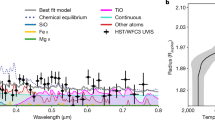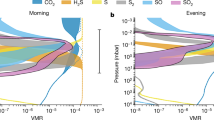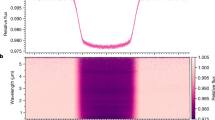Abstract
Aerosols are common in the atmospheres of exoplanets across a wide swath of temperatures, masses and ages1,2,3. These aerosols strongly impact observations of transmitted, reflected and emitted light from exoplanets, obfuscating our understanding of exoplanet thermal structure and composition4,5,6. Knowing the dominant aerosol composition would facilitate interpretations of exoplanet observations and theoretical understanding of their atmospheres. A variety of compositions have been proposed, including metal oxides and sulfides, iron, chromium, sulfur and hydrocarbons7,8,9,10,11. However, the relative contributions of these species to exoplanet aerosol opacity is unknown. Here we show that the aerosol composition of giant exoplanets observed in transmission is dominated by silicates and hydrocarbons. By constraining an aerosol microphysics model with trends in giant exoplanet transmission spectra, we find that silicates dominate aerosol opacity above planetary equilibrium temperatures of 950 K due to low nucleation energy barriers and high elemental abundances, while hydrocarbon aerosols dominate below 950 K due to an increase in methane abundance. Our results are robust to variations in planet gravity and atmospheric metallicity within the range of most giant transiting exoplanets. We predict that spectral signatures of condensed silicates in the mid-infrared are most prominent for hot (>1,600 K), low-gravity (<10 m s−2) objects.
This is a preview of subscription content, access via your institution
Access options
Access Nature and 54 other Nature Portfolio journals
Get Nature+, our best-value online-access subscription
$29.99 / 30 days
cancel any time
Subscribe to this journal
Receive 12 digital issues and online access to articles
$119.00 per year
only $9.92 per issue
Buy this article
- Purchase on Springer Link
- Instant access to full article PDF
Prices may be subject to local taxes which are calculated during checkout




Similar content being viewed by others
Data availability
Observed AH values shown in Fig. 1 are published in ref. 15 and presented in Supplementary Table 1. Model results that support Figs. 1, 2 and 4 within the main text are provided as Source Data files. Model results that support the plots in the Supplementary Information, including the temperature–pressure and eddy diffusion coefficient profiles, composition profiles, compilation of refractive indices of exoplanet aerosol materials, and synthetic transmission spectra are available from the corresponding author upon reasonable request.
Code availability
Many of the numerical models used in this work, including CARMA, the thermal structure model, the planetary interior model and the transmission spectrum model are not public. However, they are available from the corresponding author upon reasonable request. GGchem is public at https://github.com/pw31/GGchem; pymiecoated is public at https://github.com/jleinonen/pymiecoated. We include a code to compute heterogeneous and homogeneous nucleation rates, which we used to generate Fig. 3 in the main text, as a Supplementary Software file (gao_fig3_nucrate.py).
References
Skemer, A. J. et al. Directly imaged L–T transition exoplanets in the mid-infrared. Astrophys. J. 792, 17 (2014).
Sing, D. K. et al. A continuum from clear to cloudy hot-Jupiter exoplanets without primordial water depletion. Nature 529, 59–62 (2016).
Crossfield, I. J. M. & Kreidberg, L. Trends in atmospheric properties of Neptune-size exoplanets. Astron. J. 154, 261 (2017).
Barstow, J. K., Aigrain, S., Irwin, P. G. J. & Sing, D. K. A consistent retrieval analysis of 10 hot Jupiters observed in transmission. Astrophys. J. 834, 50 (2017).
Stevenson, K. B. et al. Spitzer phase curve constraints for WASP-43b at 3.6 and 4.5 µm. Astron. J. 153, 68 (2017).
Marley, M. S. et al. Reflected spectra and albedos of extrasolar giant planets. I. Clear and cloudy atmospheres. Astrophys. J. 513, 879–893 (1999).
Lodders, K. Alkali element chemistry in cool dwarf atmospheres. Astrophys. J. 519, 793–801 (1999).
Helling, C. et al. A comparison of chemistry and dust cloud formation in ultracool dwarf model atmospheres. Mon. Not. R. Astron. Soc. 391, 1854–1873 (2008).
Visscher, C., Lodders, K. & Fegley, B.Jr Atmospheric chemistry in giant planets, brown dwarfs, and low-mass dwarf stars. III. Iron, magnesium, and silicon. Astrophys. J. 716, 1060–1075 (2010).
Morley, C. V. et al. Thermal emission and reflected light spectra of super Earths with flat transmission spectra. Astrophys. J. 815, 110 (2015).
Zahnle, K., Marley, M. S., Morley, C. V. & Moses, J. I. Photolytic hazes in the atmosphere of 51 Eri B. Astrophys. J. 824, 137 (2016).
Marley, M. S., Ackerman, A. S., Cuzzi, J. N. & Kitzmann, D. In Comparative Climatology of Terrestrial Planets (eds Mackwell, S. J. et al.) 367–391 (Univ. Arizona Press, 2013).
Pruppacher, H. R. & Klett, J. D. Microphysics of Clouds and Precipitation (D. Reidel Publishing, 1978).
Stevenson, K. B. Quantifying and predicting the presence of clouds in exoplanet atmospheres. Astrophys. J. Lett. 817, L16 (2016).
Fu, G. et al. Statistical analysis of Hubble/WFC3 transit spectroscopy of extrasolar planets. Astrophys. J. Lett. 847, L22 (2017).
Morley, C. V. et al. Neglected clouds in T and Y dwarf atmospheres. Astrophys. J. 756, 172 (2012).
Parmentier, V., Fortney, J. J., Showman, A. P., Morley, C. & Marley, M. S. Transitions in the cloud composition of hot Jupiters. Astrophys. J. 828, 22 (2016).
Lodders, K. & Fegley, B. Atmospheric chemistry in giant planets, brown dwarfs, and low-mass dwarf stars. I. Carbon, nitrogen, and oxygen. Icarus 155, 393–424 (2002).
Hörst, S. M. Titan’s atmosphere and climate. J. Geophys. Res. Planets 122, 432–482 (2017).
Zhang, X., Strobel, D. F. & Imanaka, H. Haze heats Pluto’s atmosphere yet explains its cold temperature. Nature 551, 352–355 (2017).
Lavvas, P. & Koskinen, T. Aerosol properties of the atmospheres of extrasolar giant planets. Astrophys. J. 847, 32 (2017).
Komacek, T. D. & Showman, A. P. Atmospheric circulation of hot Jupiters: dayside–nightside temperature differences. Astrophys. J. 821, 16 (2016).
Powell, D., Zhang, X., Gao, P. & Parmentier, V. Formation of silicate and titanium clouds on hot Jupiters. Astrophys. J. 860, 18 (2018).
Demory, B.-O. et al. Inference of inhomogeneous clouds in an exoplanet atmosphere. Astrophys. J. Lett. 776, L25 (2013).
Showman, A. P., Lewis, N. K. & Fortney, J. J. Three-dimensional atmospheric circulation of warm and hot Jupiters: effects of orbital distance, rotation period, and nonsynchronous rotation. Astrophys. J. 801, 95 (2015).
Keating, D., Cowan, N. B. & Dang, L. Uniformly hot nightside temperatures on short-period gas giants. Nat. Astron. 3, 1092–1098 (2019).
Beatty, T. G. et al. Spitzer phase curves of KELT-1b and the signatures of nightside clouds in thermal phase observations. Astron. J. 158, 166 (2019).
Wakeford, H. R. & Sing, D. K. Transmission spectral properties of clouds for hot Jupiter exoplanets. Astron. Astrophys. 573, A122 (2015).
Heng, K. A cloudiness index for transiting exoplanets based on the sodium and potassium lines: tentative evidence for hotter atmospheres being less cloudy at visible wavelengths. Astrophys. J. Lett. 826, L16 (2016).
Tsiaras, A. et al. A population study of gaseous exoplanets. Astron. J. 155, 156 (2018).
Boggs, P. T. & Rogers, J. E. in Statistical Analysis of Measurement Error Models and Applications (eds Brown, P. J. & Fuller, W. A.) 183–194 (American Mathematical Society, 1990).
McKay, C. P., Pollack, J. B. & Courtin, R. The thermal structure of Titan’s atmosphere. Icarus 80, 23–53 (1989).
Marley, M. S. et al. Atmospheric, evolutionary, and spectral models of the brown dwarf Gliese 229 B. Science 272, 1919–1921 (1996).
Marley, M. S. & McKay, C. P. Thermal structure of Uranus’ atmosphere. Icarus 138, 268–286 (1999).
Fortney, J. J., Marley, M. S., Lodders, K., Saumon, D. & Freedman, R. Comparative planetary atmospheres: models of TrES-1 and HD 209458b. Astrophys. J. 627, L69–L72 (2005).
Fortney, J. J., Marley, M. S., Saumon, D. & Lodders, K. Synthetic spectra and colors of young giant planet atmospheres: effects of initial conditions and atmospheric metallicity. Astrophys. J. 683, 1104–1116 (2008).
Saumon, D. & Marley, M. S. The evolution of L and T dwarfs in color–magnitude diagrams. Astrophys. J. 689, 1327–1344 (2008).
Thorngren, D., Gao, P. & Fortney, J. J. The intrinsic temperature and radiative─convective boundary depth in the atmospheres of hot Jupiters. Astrophys. J. Lett. 884, L6 (2019).
Thorngren, D. P., Fortney, J. J., Murray-Clay, R. A. & Lopez, E. D. The mass–metallicity relation for giant planets. Astrophys. J. 831, 64 (2016).
Thorngren, D. P. & Fortney, J. J. Bayesian analysis of hot-Jupiter radius anomalies: evidence for ohmic dissipation? Astron. J. 155, 214 (2018).
Moses, J. I. et al. Disequilibrium carbon, oxygen, and nitrogen chemistry in the atmospheres of HD 189733b and HD 209458b. Astrophys. J. 737, 15 (2011).
Ackerman, A. S. & Marley, M. S. Precipitating condensation clouds in substellar atmospheres. Astrophys. J. 556, 872–884 (2001).
Stephens, D. C. et al. The 0.8–14.5 μm spectra of mid-L to mid-T dwarfs: diagnostics of effective temperature, grain sedimentation, gas transport, and surface gravity. Astrophys. J. 702, 154–170 (2009).
Blain, D. et al. Mapping of Jupiter’s tropospheric NH3 abundance using ground-based IRTF/TEXES observations at 5 μm. Icarus 314, 106–120 (2018).
Gao, P. & Benneke, B. Microphysics of KCl and ZnS Clouds on GJ 1214 b. Astrophys. J. 863, 165 (2018).
Turco, R. P., Hamill, P., Toon, O. B., Whitten, R. C. & Kiang, C. S. A one-dimensional model describing aerosol formation and evolution in the stratosphere: I. Physical processes and mathematical analogs. J. Atmos. Sci. 36, 699–717 (1979).
Toon, O. B., Turco, R. P., Westphal, D., Malone, R. & Liu, M. S. A multidimensional model for aerosols: description of computational analogs. J. Atmos. Sci. 45, 2123–2143 (1988).
Jacobson, M. Z. & Turco, R. P. Modeling coagulation among particles of different composition and size. Atmos. Environ. 28, 1327–1338 (1994).
Ackerman, A. S., Toon, O. B. & Hobbs, P. V. Numerical modeling of ship tracks produced by injections of cloud condensation nuclei into marine stratiform clouds. J. Geophys. Res. 100, 7121–7133 (1995).
Gao, P., Marley, M. S. & Ackerman, A. S. Sedimentation efficiency of condensation clouds in substellar atmospheres. Astrophys. J. 855, 86 (2018).
Lodders, K. Titanium and vanadium chemistry in low-mass dwarf stars. Astrophys. J. 577, 974–985 (2002).
Lee, G. K. H., Blecic, J. & Helling, C. Dust in brown dwarfs and extra-solar planets. VI. Assessing seed formation across the brown dwarf and exoplanet regimes. Astron. Astrophys. 614, A126 (2018).
Helling, C. & Woitke, P. Dust in brown dwarfs. V. Growth and evaporation of dirty dust grains. Astron. Astrophys. 455, 325–338 (2006).
Young, T. III. An essay on the cohesion of fluids. Phil. Trans. R. Soc. Lond. 95, 65–87 (1805).
Seki, J. & Hasegawa, H. The heterogeneous condensation of interstellar ice grains. Astrophys. Space Sci. 94, 177–189 (1983).
Rodriguez, J. A., Kuhn, M. & Hrbek, J. Interaction of silver, cesium, and zinc with alumina surfaces: thermal desorption and photoemission studies. J. Phys. Chem. 100, 18240–18248 (1996).
Suhasaria, T., Thrower, J. D. & Zacharias, H. Thermal desorption of ammonia from crystalline forsterite surfaces. Mon. Not. R. Astron. Soc. 454, 3317–3327 (2015).
Woitke, P. et al. Equilibrium chemistry down to 100 K: impact of silicates and phyllosilicates on the carbon to oxygen ratio. Astron. Astrophys. 614, A1 (2018).
Kawashima, Y. & Ikoma, M. Theoretical transmission spectra of exoplanet atmospheres with hydrocarbon haze: effect of creation, growth, and settling of haze particles. II. Dependence on UV irradiation intensity, metallicity, C/O ratio, eddy diffusion coefficient, and temperature. Astrophys. J. 877, 109 (2019).
Fleury, B., Gudipati, M. S., Henderson, B. L. & Swain, M. Photochemistry in hot H2-dominated exoplanet atmospheres. Astrophys. J. 871, 158 (2019).
Adams, D., Gao, P., de Pater, I. & Morley, C. V. Aggregate hazes in exoplanet atmospheres. Astrophys. J. 874, 61 (2019).
Krasnopolsky, V. A., Maillard, J. P. & Owen, T. C. Detection of methane in the Martian atmosphere: evidence for life? Icarus 172, 537–547 (2004).
Heays, A. N., Bosman, A. D. & van Dishoeck, E. F. Photodissociation and photoionisation of atoms and molecules of astrophysical interest. Astron. Astrophys. 602, A105 (2017).
Leinonen, J. Python code for calculating Mie scattering from single- and dual-layered spheres. GitHub https://github.com/jleinonen/pymiecoated (2016).
Fortney, J. J. et al. On the indirect detection of sodium in the atmosphere of the planetary companion to HD 209458. Astrophys. J. 589, 615–622 (2003).
Fortney, J. J. et al. Transmission spectra of three-dimensional hot Jupiter model atmospheres. Astrophys. J. 709, 1396–1406 (2010).
Robinson, T. D., Fortney, J. J. & Hubbard, W. B. Analytic scattering and refraction models for exoplanet transit spectra. Astrophys. J. 850, 128 (2017).
Helling, C., Gourbin, P., Woitke, P. & Parmentier, V. Sparkling nights and very hot days on WASP-18b: the formation of clouds and the emergence of an ionosphere. Astron. Astrophys. 626, A133 (2019).
Tinetti, G., Tennyson, J., Griffith, C. A. & Waldmann, I. Water in exoplanets. Phil. Trans. R. Soc. Lond. A 370, 2749–2764 (2012).
Acknowledgements
We thank M. S. Marley for his valuable insights and G. Fu for enlightening discussions. P.G. acknowledges support from the NASA Postdoctoral Program and the 51 Pegasi b Fellowship from the Heising-Simons Foundation. E.K.H.L. acknowledges support from the University of Oxford and CSH Bern through the Bernoulli Fellowship, and funding from the European community through the ERC advanced grant exocondense (number 740963). X.Z. is supported by NASA Solar System Workings grant 80NSSC19K0791. H.R.W. acknowledges support from the Giacconi Prize Fellowship at STScI, operated by AURA.
Author information
Authors and Affiliations
Contributions
P.G. conceived the research, performed the calculations and wrote the manuscript. D.P.T. provided necessary parameters for constructing the background atmospheres. E.K.H.L. supplied the equilibrium gas abundances for the various condensate species. J.J.F. and X.Z. imparted much needed guidance on the scope and structure of the manuscript. C.V.M. provided the refractive indices for most of the aerosol species considered here. H.R.W. contributed to manuscript writing and, along with K.B.S., provided guidance on data handling. D.K.P. provided insights on the aerosol microphysics model. All authors contributed to editing the manuscript.
Corresponding author
Ethics declarations
Competing interests
The authors declare no competing interests.
Additional information
Publisher’s note Springer Nature remains neutral with regard to jurisdictional claims in published maps and institutional affiliations.
Supplementary information
Supplementary Information
Supplementary Figs. 1–7 and Tables 1–4.
Supplementary Software
Python code that computes nucleation rates; can be used to recreate Fig. 3 in the main text. Python 3 required.
Source data
Source Data Fig. 1
Text file showing the model AH values that we computed for clear and cloudy atmospheres across the temperature–gravity–metallicity parameter space that we considered.
Source Data Fig. 2
Excel spreadsheet showing (sheet 1) the fractional optical depth contributions of different aerosol species at the pressures probed by transmission spectroscopy in the J or H band for the g = 10 m s−2, 10× solar atmospheric metallicity case, (sheets 2–5) pressures probed by transmission spectroscopy in the 1.4 μm water band and J or H band that we computed for clear and cloudy atmospheres across the temperature–gravity–metallicity parameter space that we considered, and (sheet 6) mean aerosol particle radius at the pressures probed by transmission spectroscopy in the J of H band that we computed for cloudy atmospheres across the temperature–gravity–metallicity parameter space that we considered.
Source Data Fig. 4
Text file showing the predicted 10 μm silicate feature amplitudes in transmission that we computed for cloudy atmospheres across the temperature–gravity–metallicity parameter space that we considered. Data are in ascii format.
Rights and permissions
About this article
Cite this article
Gao, P., Thorngren, D.P., Lee, E.K.H. et al. Aerosol composition of hot giant exoplanets dominated by silicates and hydrocarbon hazes. Nat Astron 4, 951–956 (2020). https://doi.org/10.1038/s41550-020-1114-3
Received:
Accepted:
Published:
Issue Date:
DOI: https://doi.org/10.1038/s41550-020-1114-3
This article is cited by
-
In an exoplanet atmosphere far, far away
Nature Reviews Chemistry (2024)
-
Organic hazes will impact JWST observations of water-rich exoplanets
Nature Astronomy (2023)
-
Optical properties of organic haze analogues in water-rich exoplanet atmospheres observable with JWST
Nature Astronomy (2023)
-
Vanadium oxide and a sharp onset of cold-trapping on a giant exoplanet
Nature (2023)
-
Dynamics and clouds in planetary atmospheres from telescopic observations
The Astronomy and Astrophysics Review (2023)



